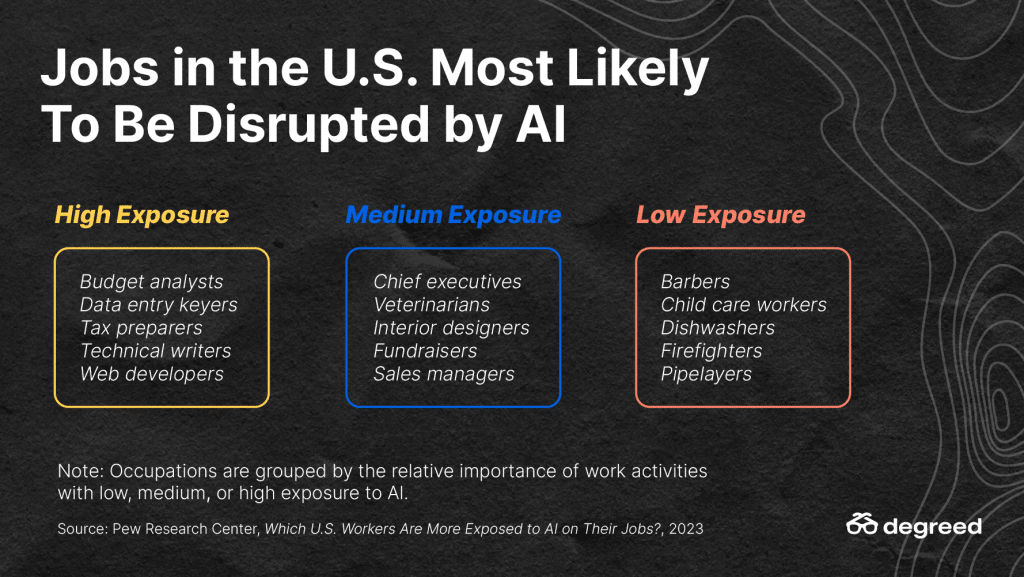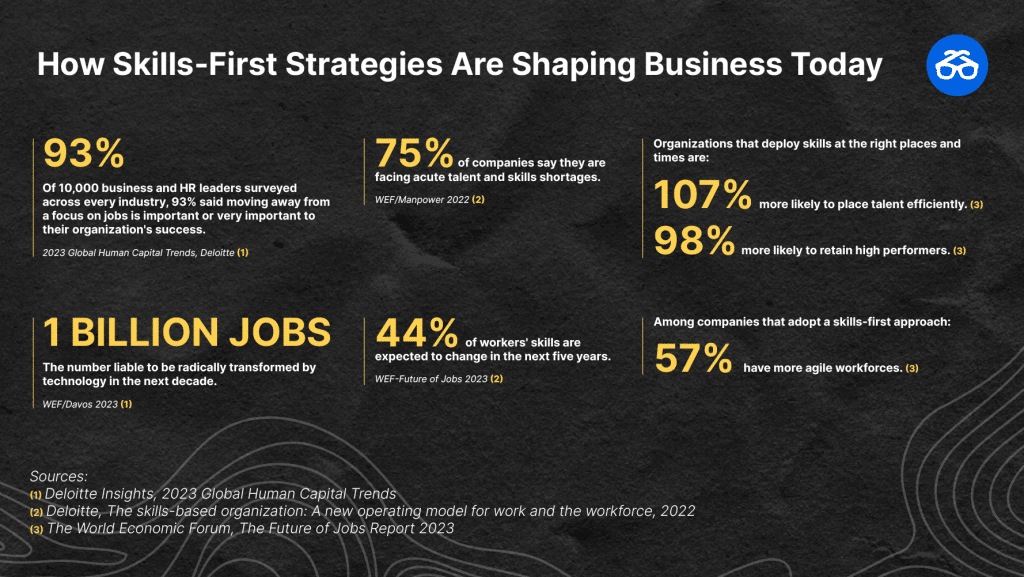AI will contribute $19.9 trillion to the global economy and drive 3.5% of global GDP through 2030. It promises to revolutionize—and disrupt—the way people work in nearly every industry.
But just 20% of leaders at enterprise companies say they have the talent they need to leverage generative AI.
Furthermore, AI threatens to displace droves of employees. Globally, 300 million full-time jobs could be exposed to automation, especially those in finance and banking, legal services, media and marketing, and IT.
If you want to fully leverage this developing technology—while reducing AI disruption across your organization—skill building will be critical. Savvy learning and business leaders are planning to not only upskill workers to use AI in their current roles—but also to reskill AI-displaced workers into new roles.

Reskilling for New Roles
AI is already displacing workers and will continue to do so. Tech giant Cisco laid off 5,500 employees in 2024 so it could invest more in AI. Meanwhile, IBM was expected to lay off or slow hiring for a whopping 26,000 roles—8,000 of them in the next five years—due to AI disruption.
But displacement doesn’t have to mean layoffs. Four in 10 surveyed leaders expect no change in headcount due to AI. They’ll need to reskill their employees to achieve that. By retaining most of a workforce, they’ll hold onto all the expertise in their organizations—like years on the job, company-specific knowledge, and rapport among workers.

Keeping Up with AI
You can reskill displaced workers into other roles, but you’ll need to start now to minimize layoffs. AI is advancing so quickly that workers need new skills now just to keep up. The good news is that skill building doesn’t have to take a lot of time. Just ask Verizon.
During the COVID-19 pandemic, Verizon closed 70% of its physical stores—while simultaneously needing far more telesales and remote customer service reps. Verizon retrained nearly 20,000 displaced workers—some of them completing just eight additional hours of training before starting their new roles. How was it possible? In-store workers already had plenty of customer service skills, brand knowledge, and product experience.
If you see the threat of displacement as you forge into AI territory, look for adjacent roles for at-risk employees.
For example, if a new AI chatbot displaces some of your customer service staff, you could quickly reskill people into sales positions, because they already have high emotional intelligence, product expertise, and communication skills.
Staying Curious
Another key to the Verizon success was foresight. While leaders couldn’t have predicted the pandemic, they had already been experimenting with remote work. The company had piloted remote customer service and telesales programs for some employees. It had invested in the right technology and knew how to train people into those roles.
So when disruption came, it was just a matter of scaling those efforts.
While you can’t predict exactly how AI will disrupt your business, you can start building some tactical advantages now. Make small investments to explore AI uses so you’re ready to lean into them if it makes sense to later. Stay curious about AI even in its early stages, even if it’s not as capable as you’d like yet.
An impressive Ericsson success metric reveals the power of this path: Five years ago, the telecom giant began upskilling a relatively small group of 300 scientists to use artificial intelligence. Ericsson used Degreed to support its focus on 5G and AI technologies, emphasizing agility and ensuring employees had the necessary skills to meet evolving industry demands. Now, more than 30,000 of the company’s 100,000-plus employees are considered very proficient in AI.
Check out Degreed Experiments for some L&D-specific examples of ways you can start planning for—and start using—AI today.
Reskilling for AI Roles
While some workers will be displaced because of AI, others will need to leverage it to keep their companies competitive. Upskilling workers in their current roles is critical. You’ll also need to be ready to move staff into new AI-support roles. For example, you might need someone to track the value creation of your AI initiatives, validate AI-created content, or conduct internal audits to ensure regulatory compliance.

Here, too, there’s no time to waste. AI is developing so quickly that failing to keep up with the necessary skills could sandbag your investments.
Using AI to Teach AI
Luckily, AI is proving to be just as useful in L&D as it is elsewhere. Consider making your first AI investments in learning, so you lay the groundwork for developing an entire workforce of AI-savvy smarties.
- Use generative AI tech to quickly create and market learning content throughout your company.
- Use automations like those offered by Degreed to quickly deliver the right content to the right people—and keep them engaged in learning.
- Embrace AI coaches like Degreed Maestro to pinpoint individual needs and personalize learning at scale.
Teach employees how to learn, not just what to learn, so they become skilled at reskilling themselves. They’ll become better at keeping up with the ways AI impacts their work than you are.

Planning for AI Disruption
Because AI promises to drastically change the way people work, it’ll also change the way people organize work. How do you structure new roles around the future of this technology? Right now, with AI disruption still so fresh, it’s nearly impossible. But you can find ways to build adaptability right into your talent.
Consider changes made and shared with us by the technology transformation experts at CI&T. Leaders there have democratized AI skills so workers find ways to use it in their roles. All employees can train to use its AI development tool (FLOW) to benefit from AI in their roles. And it’s working. Since its launch, 38% of employees use FLOW, 12% have been certified, and CI&T has successfully adopted it for 9 of 10 clients in 6 months.
Another way to get ready? Build in the ultimate adaptability by becoming a skills-first org (SFO).
A skills-first organization prioritizes skills as the organizing unit for its workforce. It leverages skills data from platforms like Degreed to inform talent and management practices. These insights help leaders understand workforce capabilities, development needs, and deployment options.

Focusing on skills (rather than job titles or formal educational requirements) gives you a structure for homing in on the exact skills workers need, speeds them toward upskilling and readiness, and helps you flexibly organize workers to deploy projects as needs arise.
Making the shift to a skills-first strategy is at least as big of a change as adopting AI. That’s why we created The Ultimate Guide to a Skills-First Future. Download it today to start building the kind of adaptability you’ll need to help your workforce keep up with AI disruption.
Find out more.
Explore The Ultimate Guide to a Skills-First Future—to find out why skills-based strategies matter and how you can get started.

